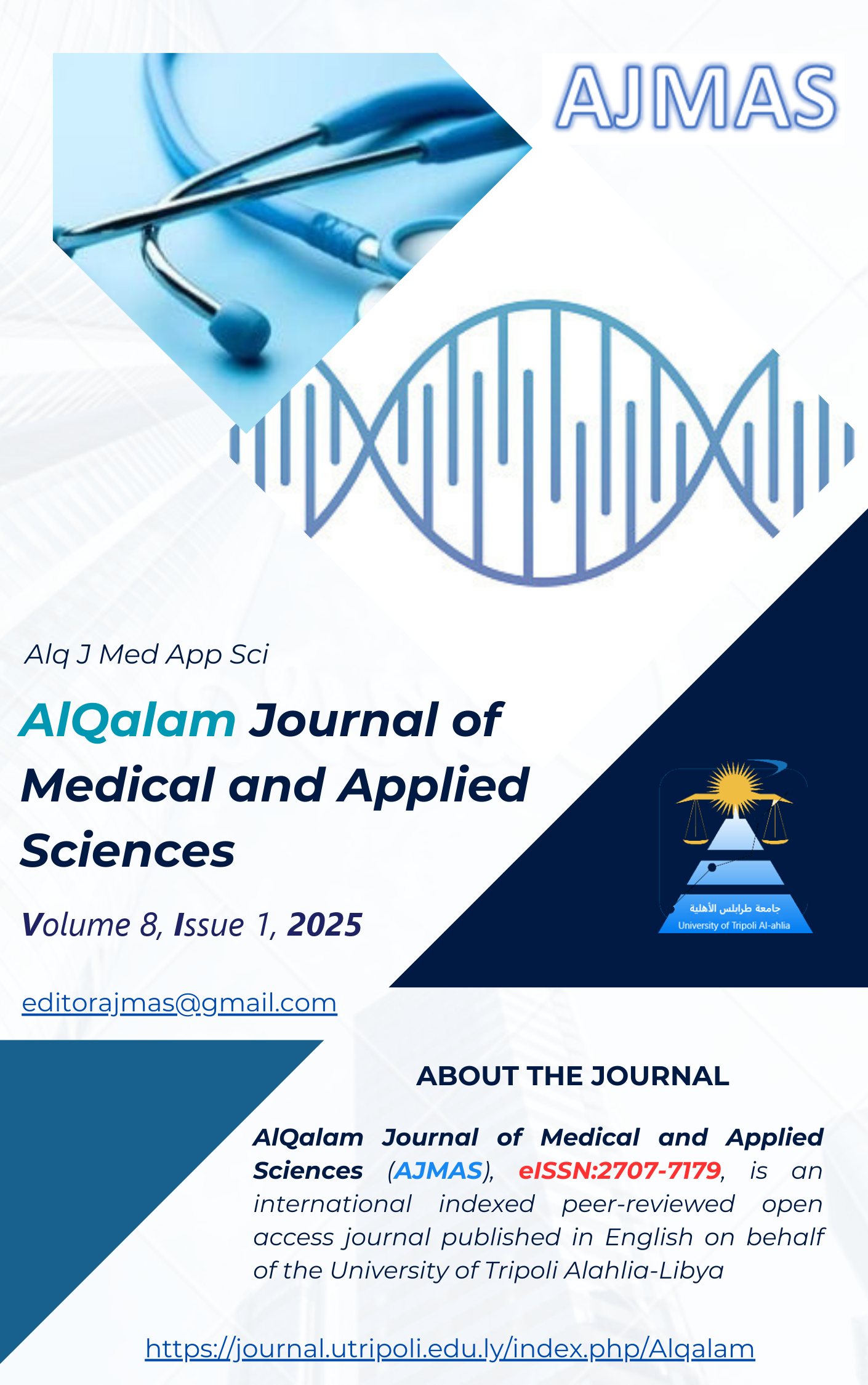Profiling the Bacterial Infection-Infertility Nexus Among Clinical Populations of Tripoli-Libya
DOI:
https://doi.org/10.54361/ajmas.258164Keywords:
Infertility, Bacterial Vaginosis, Lactobacilli, H. Pylori, Microbiota.Abstract
Infertility is the inability to conceive after one year of regular unprotected intercourse, or six months for women aged 35 years and older. It can be defined as the inability to achieve pregnancy without medical intervention. Affecting 15% of couples globally, bacterial infections can contribute to infertility, affecting one in seven couples in the West and one in four in developing nations. Infertility rates can reach 30% in regions such as South Asia, sub-Saharan Africa, the Middle East, North Africa, Eastern Europe, and Central Asia. Various factors, such as congenital and hormonal disorders, lifestyle changes, stress, and environmental factors, can contribute to infertility. This study aimed to examine the link between infertility and bacterial infection in Tripoli, Libya, by analysing medical records from the National Infertility Centre and private labs. It seeks to identify the most common bacteria associated with fertility issues and assess the impact of bacterial infections on infertility, considering factors such as PCOS. The prevalence of infertility in both men and women was also determined. A total of 302 medical files of 151 males and 151 females from 2023-2024 were analyzed. Risk factors such as hypertension, diabetes mellitus, and smoking were also explored across different age groups. Statistical analysis using SPSS software revealed the relationship between infertility and bacterial infections, which are presented in tables, frequencies, and P-values. However, this study revealed that 80.1% of the studied patients were infertile. Of the infertile cases, 39.4% had bacterial infections, 19.9% were not infertile, and 123 (40.7%) had non-bacterial infections or infertility. Based on the collected data, this study concluded a strong correlation between infertility and bacterial infection in males (81.5%) compared to females (18.4%), with a P-value (<0.05).
العقم هو عدم القدرة على الحمل بعد عام واحد من الجماع المنتظم غير المحمي، أو ستة أشهر للنساء في سن 35 عامًا فأكثر. يمكن تعريفه بأنه عدم القدرة على تحقيق الحمل دون تدخل طبي. تؤثر العدوى البكتيرية على 15٪ من الأزواج على مستوى العالم، ويمكن أن تسهم في العقم، مما يؤثر على واحد من كل سبعة أزواج في الغرب وواحد من كل أربعة في الدول النامية. يمكن أن تصل معدلات العقم إلى 30٪ في مناطق مثل جنوب آسيا وأفريقيا جنوب الصحراء الكبرى والشرق الأوسط وشمال إفريقيا وأوروبا الشرقية وآسيا الوسطى. يمكن أن تساهم عوامل مختلفة، مثل الاضطرابات الخلقية والهرمونية، وتغيرات نمط الحياة، والإجهاد، والعوامل البيئية، في العقم. هدفت هذه الدراسة إلى دراسة العلاقة بين العقم والعدوى البكتيرية في طرابلس، ليبيا، من خلال تحليل السجلات الطبية من المركز الوطني للعقم والمختبرات الخاصة. تسعى إلى تحديد البكتيريا الأكثر شيوعًا المرتبطة بقضايا الخصوبة وتقييم تأثير العدوى البكتيرية على العقم، مع مراعاة عوامل مثل متلازمة تكيس المبايض. تم تحديد انتشار العقم لدى كل من الرجال والنساء أيضًا. تم تحليل ما مجموعه 302 ملفًا طبيًا لـ 151 ذكرًا و 151 أنثى من عامي 2023-2024. كما تم استكشاف عوامل الخطر مثل ارتفاع ضغط الدم ومرض السكري والتدخين عبر الفئات العمرية المختلفة. كشف التحليل الإحصائي باستخدام برنامج SPSS عن العلاقة بين العقم والالتهابات البكتيرية، والتي يتم تقديمها في الجداول والترددات والقيم الاحتمالية. ومع ذلك، كشفت هذه الدراسة أن 80.1٪ من المرضى الذين تمت دراستهم كانوا يعانون من العقم. من بين حالات العقم، كان 39.4٪ مصابين بالعدوى البكتيرية، و 19.9٪ لم يكونوا مصابين بالعقم، و 123 (40.7٪) مصابين بعدوى غير بكتيرية أو عقم. بناءً على البيانات التي تم جمعها، خلصت هذه الدراسة إلى وجود علاقة قوية بين العقم والعدوى البكتيرية لدى الذكور (81.5٪) مقارنة بالإناث (18.4٪)، بقيمة احتمالية (<0.05)
Downloads
Published
How to Cite
Issue
Section
License
Copyright (c) 2025 Salah Mohamed, Abdalla Hamed, Mohamed Hamed, Attiyia Alateri

This work is licensed under a Creative Commons Attribution 4.0 International License.














